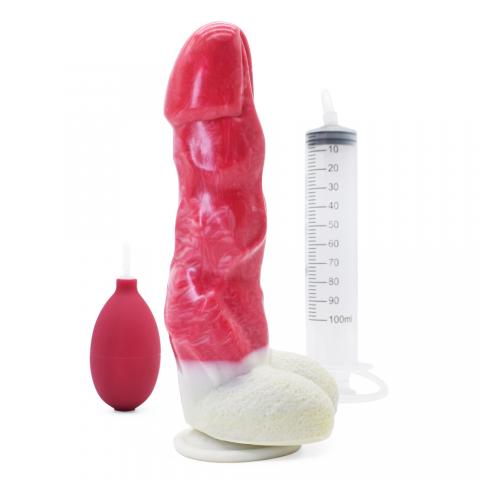Login
 USD $
USD $
 AUD AUD
AUD AUD CAD CAD
CAD CAD GBP £
GBP £ EUR €
EUR €
All Categories
(0) My Cart (0)
LambskinMushroom DildoNew ArrivalCheap
pleated filter cartridge factory
high flow filter cartridge
large flow filter cartridge
membrane pleated filter cartridge
capsule filter suppliers
capsule filter 0.2 micron
capsule filter price
capsule filter
water filter cartridge
New Products
Four treatments for AIDS introduce how to prevent mother-to-child transmission of AIDS
AIDS patients and HIV carriers. HIV exists in the body fluids and organs of infected people, and the blood lesbian vibrator , semen, vaginal secretion chastity cage , milk and wound exudate of infected people contain a large amount of HIV, which is highly infectious. Tears, saliva, sweat, urine, feces, etc. do not contain this virus without blood and inflammatory exudate, and it is not contagious.
A detailed interpretation of the ways of transmission of AIDS
1. Sexual contact transmission
Sexually transmitted HIV exists in the semen and vaginal secretions of infected people, and spreads between men and women through sexual intercourse (including normal sexual intercourse, anal intercourse and oral sex). Worldwide, 9 out of every 10 adults infected with HIV are transmitted through sexual intercourse, and the more sexual partners there are, the greater the risk of HIV infection. People with venereal diseases are easily infected with HIV when they have sex with people infected with HIV.
Sexual contact transmission is the main way of HIV infection. The spread of HIV can occur in both homosexual and heterosexual intercourse. Worldwide, HIV is mostly transmitted through heterosexual contact. The rate of HIV transmission among adults is shown in the table:
Route of transmission ratio
71% of heterosexual transmission
Homosexuality spread 15%
7% of intravenous drug users
Bloody transmission 5%
Other reasons unknown 2%
In North America and Europe, male homosexual sexual contact-transanal sexual intercourse is the main mode of transmission of the disease. Homosexual and bisexual men are the main groups of HIV infection. 's initial discovery of AIDS patients in the United States is mainly concentrated in gay men. Anal intercourse between gay men can easily cause anal and rectal mucosal trauma, which opens the channel for HIV to enter the bloodstream, so that semen containing a large amount of HIV and male secretions before ejaculation enter the blood circulation through the damaged mucous membrane. In addition penis vibrator , gay men often exchange sexual partners, and some homosexuals have dozens or hundreds of sexual partners, which increases the chance of HIV infection. In Africa and Latin American countries and Southeast Asia, the vast majority of AIDS is infected through heterosexual contact and vaginal intercourse. The prevalence rate of AIDS is 1:1 in the ratio of male to female. The transmission of HIV among members of the opposite sex can be divided into two ways: male → female or female → male. Compared with the two ways, the risk of male → transmission in female was higher than that in female → male transmission. Both semen and cervical secretions can carry HIV. Anatomically, secretions can be retained in women rather than men, so the transmission caused by the exchange of semen and cervical secretions is more effective in men and women with →. In some African countries, there is a custom in which a wife is inherited by her husband's brother after her husband's death, the purpose of which is to prevent the loss of family property. But this inheritance in today's AIDS epidemic in Africa, its inheritance of brothers and wives, but also inherited a deadly dowry, that is, HIV. HIV-positive wives can transmit the virus to their husbands' brothers, so both male → and female → males are important routes of transmission in Africa. Prostitution and whoring play an important role in the spread of AIDS. Clients with HIV transmit the virus to prostitutes, who then transmit it to other clients. If combined with sexually transmitted diseases, the chance of spreading HIV can be greatly increased. Genital erosion and ulcers open the channel for the virus to enter the blood circulation, and the party with genital ulcers is more likely to be infected with HIV. In Southeast Asia, the prevalence of prostitution and whoring has led to the rapid spread of HIV infection. In Thailand, for example, HIV infection rates have increased at an alarming rate since 1990.
Bisexual men are highly dangerous not only to male sexual partners, but also to female sexual partners. Many people in bisexuality are married and may often have sex with prostitutes. These bisexuals who marry or often have sexual contact with the opposite sex may introduce the spread of homosexuality into heterosexual people. Therefore, homosexual and heterosexual sexual behaviors of bisexual men play an important role in the spread of HIV.
The main sexual behaviors related to HIV transmission are transanal sexual intercourse and transvaginal sexual intercourse. Cases of HIV transmission through oral sexual intercourse are rarely reported and are considered to be low-risk sexual behavior. However, if there is oral mucosal erosion or ulcer, it significantly increases the risk of oral sexual intercourse to spread HIV.
2. Transmission by blood
Mainly through the import of HIV-contaminated blood and blood products or the use of HIV-contaminated syringes, needles and spread. It can also be spread through the use of contaminated and unsterilized needle tattoos, ear piercing, acupuncture, and sharing razors and toothbrushes with patients and infected people.
Sharing injection equipment contaminated by HIV, inputting blood or blood components contaminated by HIV, transplanting tissues and organs contaminated by HIV belong to blood transmission. Intravenous drug use has become the second major part of HIV infection in the United States and Western Europe. In some provinces and cities in southern China, intravenous drug use is a major way to spread AIDS. The spread of HIV is due to sharing blood-contaminated needles, syringes and injectable paraphernalia. At the same time, most drug addicts are sexually active, and many of them are infected by HIV due to sexual behavior. They engage in sex or prostitution in exchange for drugs or money. Some studies have found that under general hospital conditions, the probability of using needles and tips contaminated by HIV to pierce the skin at once and infect HIV is 0.3%. Intravenous drug users often draw blood repeatedly to flush out the drugs in the tube, and the blood contaminated by HIV remains in the needle. Generally, HIV in the blood can survive for 15 days at room temperature, and other drug users become infected when they use contaminated syringes. As the number of people sharing syringes increases, so does the risk of HIV infection. On the other hand, drug abuse often increases the desire for sexual contact, if the sex trade in exchange for drugs, will further increase the risk of HIV infection.
Blood transfusion or blood components is one of the important ways of transmission in the early stage of the AIDS epidemic. With the development of modern medicine, blood transfusion or blood products are more and more widely used. Through blood transfusions and blood products, countless patients' lives have been saved. However, if blood or blood products contaminated by HIV are transferred, HIV is directly injected into the blood circulation. Blood components such as V-Ⅲ factor concentrators are extracted from the plasma of many blood donors, so they are more likely to contaminate HIV. About 6 per cent of US blood donors carry HIV, so's early US-made V-Ⅲ factor concentrate caused infection in hemophiliacs around the world. Thousands of healthy blood recipients have been infected with AIDS as a result of HIV contamination at a blood center in France. There must be a long warning about these painful lessons. Now developed countries have strengthened the screening of blood donors, and our country is also constantly strengthening the management of blood donors and blood products. If the blood donor is infected with HIV and the blood supply is in the window period, the HIV antibody can not be detected. At present, it is not possible to detect HIV antigen in all blood donors, because the equipment for detecting HIV antigen is complex and expensive. In view of this, it is very important to strengthen and improve the screening system for blood donors, and blood transfusions and blood transfusion products must be cautious.
Organ transplantation technology is an important development of modern medicine. Many patients with end-stage heart, lung, liver, kidney and other organ diseases can be reborn through organ transplantation, but the damaged organs are potentially dangerous. Routine HIV antibody detection of organ donors can significantly reduce the transmission of HIV by organ transplantation. The Centers for Disease Control in the United States has reported that many patients who received kidney, liver, bone marrow transplants were infected with HIV. The iatrogenic transmission is gradually decreasing in the developed countries where HIV is still prevalent. Although the number of people who get sick through this mode of transmission is very small, the impact is significant because it is related to public health problems.
3, mother-to-child transmission mother is AIDS patients or infected, in the process of pregnancy, delivery through the blood or postpartum through breast milk to transmit HIV to the fetus or newborn. Women who have been infected with HIV give birth to children who are likely to be infected with HIV from their mothers. Most children with HIV will die before the age of 3.
AIDS in children, which is vertically transmitted by mothers, was first reported in 1982. This transmission may occur in the uterine cavity, or it may occur during delivery and during postpartum breastfeeding through breast milk containing HIV to the baby.
HIV can be transmitted to the fetus through the placenta. It has been proved that HIV can be isolated from fetuses aborted at 8 weeks of pregnancy. The transmission rate of mother to fetus determines the development stage and immune function of mother infected with HIV, such as the number of T4 lymphocytes and so on. After the fetus is infected with HIV in the womb, it will affect the embryonic development, prone to abortion, or the fetus has developed into AIDS at birth. The earlier the fetus is infected by HIV in the womb nice ass , the more likely it is to have a miscarriage or affect the fetal development. The earlier the fetus develops AIDS-related symptoms after birth, the shorter its survival time. At Ndola Pediatric Hospital in Zambia, a total of 265 neonatal HIV/AIDS patients were treated in 1993, of which 86 per cent developed illness in the first 3 weeks of life, including septicemia, bronchitis, deep jaundice and skin lesions, and 74.5 per cent died within 3 months of birth. Newborns who develop the disease within 1 month after birth generally survive no more than 6 months. Mother-to-child transmission may also occur in the process of vaginal delivery. If the fetus has skin and mucous membrane damage during delivery, the HIV in the maternal blood enters the infant blood circulation through the injured wound. Some studies have reported that caesarean section can reduce the transmission of HIV infection from mother to baby.
The virus can be isolated from the milk of HIV-infected mothers, and breastfeeding can transmit HIV to the baby. It has been reported that a mother was infected with HIV after a postpartum blood transfusion and her baby was infected with HIV after sucking her breast milk for 6 months. However, it is not clear how likely it is to be infected with HIV through breastfeeding. Health authorities in the United States have advised mothers with HIV infection not to breastfeed. In many countries in Africa, due to poor economic conditions and insufficient breast milk substitutes, stopping breastfeeding will lead to serious malnutrition, which will endanger the survival of babies faster than HIV infection, so mothers infected with HIV in many African countries still advocate breastfeeding.
Measures to prevent HIV transmission from mother to child include persuading women infected with HIV not to have children and finding pregnant women.
Pregnancy should be terminated. Because of fetal HIV infection, most of them die within 3 years of age after birth, and babies who survive will also become chronically ill children and motherless orphans. There are many ethical, moral and emotional problems here.
Introduction of four treatment methods for AIDS
1. General supportive therapy: including physical and mental rest and nutritional supply.
2. control of opportunistic infections and treatment of malignant tumors: most opportunistic infections have special specific drugs, using a variety of antibacterial, antifungal and antiprotozoal drugs to treat opportunistic infections in AIDS patients under the guidance of a doctor. For malignant tumors, it is up to the doctor to decide to use radiotherapy, chemotherapy or surgery.
3. Anti-HIV drugs. Directly inhibit the reverse transcriptase activity of the virus and prevent the virus from replicating in human cells, such as azido thymidine (azidothymidine,AZT) and dideoxyinosine (dideoxylno-sine,DDI). These two drugs have been widely used in clinic. After taking drugs, some patients can not completely inhibit the process of virus replication in the body and reduce the number of viruses; but once the dose is reduced or stopped, the virus level immediately rebounds, obviously these two drugs can not cure AIDS, but can only slow down the disease and prolong survival.
In recent years, after using AZT to treat thousands of people infected with HIV in the United States, it has been found that the use of AZT in advance before the onset of the disease can delay the onset of the disease. Pregnant women who have been infected with HIV have taken AZT, which can reduce the risk of vertical transmission of mother-to-child virus, and the HIV infection rate of their babies is significantly lower than that of pregnant women in the placebo group without drug effects.
4. Immune support therapy: one is the drugs that block the combination of HIV and human cells, most of which belong to antibody type. It can be a surface antigen against the virus or an antibody against the T4 cell receptor to block the binding of the two, but only in the laboratory stage. The other is biological factors, such as interferon, interleukin and other factors that affect the differentiation or growth of lymphocytes, but they are still far from practical application. The recently proposed blood transfusion therapy also falls into this category.
How to prevent mother-to-child transmission of AIDS
1. Women infected with HIV should not become pregnant.
2. Clinical practice in recent years has found that giving the drug diazide thymidine to treat AIDS three months before delivery can prevent 70% of babies born to mothers with HIV from being infected with HIV.
3. Women with HIV do not breastfeed their babies after giving birth, because HIV can be transmitted through breast milk.
Realistic dildo | best vibrator | pvc dildo | fat pocket pussy
A detailed interpretation of the ways of transmission of AIDS
1. Sexual contact transmission
Sexually transmitted HIV exists in the semen and vaginal secretions of infected people, and spreads between men and women through sexual intercourse (including normal sexual intercourse, anal intercourse and oral sex). Worldwide, 9 out of every 10 adults infected with HIV are transmitted through sexual intercourse, and the more sexual partners there are, the greater the risk of HIV infection. People with venereal diseases are easily infected with HIV when they have sex with people infected with HIV.
Sexual contact transmission is the main way of HIV infection. The spread of HIV can occur in both homosexual and heterosexual intercourse. Worldwide, HIV is mostly transmitted through heterosexual contact. The rate of HIV transmission among adults is shown in the table:
Route of transmission ratio
71% of heterosexual transmission
Homosexuality spread 15%
7% of intravenous drug users
Bloody transmission 5%
Other reasons unknown 2%
In North America and Europe, male homosexual sexual contact-transanal sexual intercourse is the main mode of transmission of the disease. Homosexual and bisexual men are the main groups of HIV infection. 's initial discovery of AIDS patients in the United States is mainly concentrated in gay men. Anal intercourse between gay men can easily cause anal and rectal mucosal trauma, which opens the channel for HIV to enter the bloodstream, so that semen containing a large amount of HIV and male secretions before ejaculation enter the blood circulation through the damaged mucous membrane. In addition penis vibrator , gay men often exchange sexual partners, and some homosexuals have dozens or hundreds of sexual partners, which increases the chance of HIV infection. In Africa and Latin American countries and Southeast Asia, the vast majority of AIDS is infected through heterosexual contact and vaginal intercourse. The prevalence rate of AIDS is 1:1 in the ratio of male to female. The transmission of HIV among members of the opposite sex can be divided into two ways: male → female or female → male. Compared with the two ways, the risk of male → transmission in female was higher than that in female → male transmission. Both semen and cervical secretions can carry HIV. Anatomically, secretions can be retained in women rather than men, so the transmission caused by the exchange of semen and cervical secretions is more effective in men and women with →. In some African countries, there is a custom in which a wife is inherited by her husband's brother after her husband's death, the purpose of which is to prevent the loss of family property. But this inheritance in today's AIDS epidemic in Africa, its inheritance of brothers and wives, but also inherited a deadly dowry, that is, HIV. HIV-positive wives can transmit the virus to their husbands' brothers, so both male → and female → males are important routes of transmission in Africa. Prostitution and whoring play an important role in the spread of AIDS. Clients with HIV transmit the virus to prostitutes, who then transmit it to other clients. If combined with sexually transmitted diseases, the chance of spreading HIV can be greatly increased. Genital erosion and ulcers open the channel for the virus to enter the blood circulation, and the party with genital ulcers is more likely to be infected with HIV. In Southeast Asia, the prevalence of prostitution and whoring has led to the rapid spread of HIV infection. In Thailand, for example, HIV infection rates have increased at an alarming rate since 1990.
Bisexual men are highly dangerous not only to male sexual partners, but also to female sexual partners. Many people in bisexuality are married and may often have sex with prostitutes. These bisexuals who marry or often have sexual contact with the opposite sex may introduce the spread of homosexuality into heterosexual people. Therefore, homosexual and heterosexual sexual behaviors of bisexual men play an important role in the spread of HIV.
The main sexual behaviors related to HIV transmission are transanal sexual intercourse and transvaginal sexual intercourse. Cases of HIV transmission through oral sexual intercourse are rarely reported and are considered to be low-risk sexual behavior. However, if there is oral mucosal erosion or ulcer, it significantly increases the risk of oral sexual intercourse to spread HIV.
2. Transmission by blood
Mainly through the import of HIV-contaminated blood and blood products or the use of HIV-contaminated syringes, needles and spread. It can also be spread through the use of contaminated and unsterilized needle tattoos, ear piercing, acupuncture, and sharing razors and toothbrushes with patients and infected people.
Sharing injection equipment contaminated by HIV, inputting blood or blood components contaminated by HIV, transplanting tissues and organs contaminated by HIV belong to blood transmission. Intravenous drug use has become the second major part of HIV infection in the United States and Western Europe. In some provinces and cities in southern China, intravenous drug use is a major way to spread AIDS. The spread of HIV is due to sharing blood-contaminated needles, syringes and injectable paraphernalia. At the same time, most drug addicts are sexually active, and many of them are infected by HIV due to sexual behavior. They engage in sex or prostitution in exchange for drugs or money. Some studies have found that under general hospital conditions, the probability of using needles and tips contaminated by HIV to pierce the skin at once and infect HIV is 0.3%. Intravenous drug users often draw blood repeatedly to flush out the drugs in the tube, and the blood contaminated by HIV remains in the needle. Generally, HIV in the blood can survive for 15 days at room temperature, and other drug users become infected when they use contaminated syringes. As the number of people sharing syringes increases, so does the risk of HIV infection. On the other hand, drug abuse often increases the desire for sexual contact, if the sex trade in exchange for drugs, will further increase the risk of HIV infection.
Blood transfusion or blood components is one of the important ways of transmission in the early stage of the AIDS epidemic. With the development of modern medicine, blood transfusion or blood products are more and more widely used. Through blood transfusions and blood products, countless patients' lives have been saved. However, if blood or blood products contaminated by HIV are transferred, HIV is directly injected into the blood circulation. Blood components such as V-Ⅲ factor concentrators are extracted from the plasma of many blood donors, so they are more likely to contaminate HIV. About 6 per cent of US blood donors carry HIV, so's early US-made V-Ⅲ factor concentrate caused infection in hemophiliacs around the world. Thousands of healthy blood recipients have been infected with AIDS as a result of HIV contamination at a blood center in France. There must be a long warning about these painful lessons. Now developed countries have strengthened the screening of blood donors, and our country is also constantly strengthening the management of blood donors and blood products. If the blood donor is infected with HIV and the blood supply is in the window period, the HIV antibody can not be detected. At present, it is not possible to detect HIV antigen in all blood donors, because the equipment for detecting HIV antigen is complex and expensive. In view of this, it is very important to strengthen and improve the screening system for blood donors, and blood transfusions and blood transfusion products must be cautious.
Organ transplantation technology is an important development of modern medicine. Many patients with end-stage heart, lung, liver, kidney and other organ diseases can be reborn through organ transplantation, but the damaged organs are potentially dangerous. Routine HIV antibody detection of organ donors can significantly reduce the transmission of HIV by organ transplantation. The Centers for Disease Control in the United States has reported that many patients who received kidney, liver, bone marrow transplants were infected with HIV. The iatrogenic transmission is gradually decreasing in the developed countries where HIV is still prevalent. Although the number of people who get sick through this mode of transmission is very small, the impact is significant because it is related to public health problems.
3, mother-to-child transmission mother is AIDS patients or infected, in the process of pregnancy, delivery through the blood or postpartum through breast milk to transmit HIV to the fetus or newborn. Women who have been infected with HIV give birth to children who are likely to be infected with HIV from their mothers. Most children with HIV will die before the age of 3.
AIDS in children, which is vertically transmitted by mothers, was first reported in 1982. This transmission may occur in the uterine cavity, or it may occur during delivery and during postpartum breastfeeding through breast milk containing HIV to the baby.
HIV can be transmitted to the fetus through the placenta. It has been proved that HIV can be isolated from fetuses aborted at 8 weeks of pregnancy. The transmission rate of mother to fetus determines the development stage and immune function of mother infected with HIV, such as the number of T4 lymphocytes and so on. After the fetus is infected with HIV in the womb, it will affect the embryonic development, prone to abortion, or the fetus has developed into AIDS at birth. The earlier the fetus is infected by HIV in the womb nice ass , the more likely it is to have a miscarriage or affect the fetal development. The earlier the fetus develops AIDS-related symptoms after birth, the shorter its survival time. At Ndola Pediatric Hospital in Zambia, a total of 265 neonatal HIV/AIDS patients were treated in 1993, of which 86 per cent developed illness in the first 3 weeks of life, including septicemia, bronchitis, deep jaundice and skin lesions, and 74.5 per cent died within 3 months of birth. Newborns who develop the disease within 1 month after birth generally survive no more than 6 months. Mother-to-child transmission may also occur in the process of vaginal delivery. If the fetus has skin and mucous membrane damage during delivery, the HIV in the maternal blood enters the infant blood circulation through the injured wound. Some studies have reported that caesarean section can reduce the transmission of HIV infection from mother to baby.
The virus can be isolated from the milk of HIV-infected mothers, and breastfeeding can transmit HIV to the baby. It has been reported that a mother was infected with HIV after a postpartum blood transfusion and her baby was infected with HIV after sucking her breast milk for 6 months. However, it is not clear how likely it is to be infected with HIV through breastfeeding. Health authorities in the United States have advised mothers with HIV infection not to breastfeed. In many countries in Africa, due to poor economic conditions and insufficient breast milk substitutes, stopping breastfeeding will lead to serious malnutrition, which will endanger the survival of babies faster than HIV infection, so mothers infected with HIV in many African countries still advocate breastfeeding.
Measures to prevent HIV transmission from mother to child include persuading women infected with HIV not to have children and finding pregnant women.
Pregnancy should be terminated. Because of fetal HIV infection, most of them die within 3 years of age after birth, and babies who survive will also become chronically ill children and motherless orphans. There are many ethical, moral and emotional problems here.
Introduction of four treatment methods for AIDS
1. General supportive therapy: including physical and mental rest and nutritional supply.
2. control of opportunistic infections and treatment of malignant tumors: most opportunistic infections have special specific drugs, using a variety of antibacterial, antifungal and antiprotozoal drugs to treat opportunistic infections in AIDS patients under the guidance of a doctor. For malignant tumors, it is up to the doctor to decide to use radiotherapy, chemotherapy or surgery.
3. Anti-HIV drugs. Directly inhibit the reverse transcriptase activity of the virus and prevent the virus from replicating in human cells, such as azido thymidine (azidothymidine,AZT) and dideoxyinosine (dideoxylno-sine,DDI). These two drugs have been widely used in clinic. After taking drugs, some patients can not completely inhibit the process of virus replication in the body and reduce the number of viruses; but once the dose is reduced or stopped, the virus level immediately rebounds, obviously these two drugs can not cure AIDS, but can only slow down the disease and prolong survival.
In recent years, after using AZT to treat thousands of people infected with HIV in the United States, it has been found that the use of AZT in advance before the onset of the disease can delay the onset of the disease. Pregnant women who have been infected with HIV have taken AZT, which can reduce the risk of vertical transmission of mother-to-child virus, and the HIV infection rate of their babies is significantly lower than that of pregnant women in the placebo group without drug effects.
4. Immune support therapy: one is the drugs that block the combination of HIV and human cells, most of which belong to antibody type. It can be a surface antigen against the virus or an antibody against the T4 cell receptor to block the binding of the two, but only in the laboratory stage. The other is biological factors, such as interferon, interleukin and other factors that affect the differentiation or growth of lymphocytes, but they are still far from practical application. The recently proposed blood transfusion therapy also falls into this category.
How to prevent mother-to-child transmission of AIDS
1. Women infected with HIV should not become pregnant.
2. Clinical practice in recent years has found that giving the drug diazide thymidine to treat AIDS three months before delivery can prevent 70% of babies born to mothers with HIV from being infected with HIV.
3. Women with HIV do not breastfeed their babies after giving birth, because HIV can be transmitted through breast milk.
Realistic dildo | best vibrator | pvc dildo | fat pocket pussy
Read More huge dildo
Subscribe for Join Us!
Subcribe to get $10 OFF for order.
- Information
- About us
- Contact us
- Customer Service
- Privacy Policy
- Return Policy
- Shopping Guide
- Payment Methods
- Products
- Dildos
- Vibrators
- Penis Pumps
- Masturbation Cup
- Love Egg
- Contact Us
- [email protected]
- Room 1003, Chevalier House, 188 Chatham Road South, Tsim Sha Tsui, Kowloon, Hong Kong
CopyRight © wlovew.com 2002-2025













-
Follow Us On WhatsApp
My Cart (0)
Follow Us On WhatsApp













